So you want to read Diana Wynne Jones. Congratulations! An excellent decision, if I do say so myself. But now what?
For an author who produced a book a year for forty years, figuring out which book to read first is no mean feat. With a catalogue as long as hers and full of so many related and unrelated series, there’s no reason you have to start at the beginning. Lucky for you, I am a huge fan and ready to get on my soapbox and sing her praises.
I cried the day Diana Wynne Jones died. I barely knew her as an author at that point, but the little I had read had affected me deeply. She is up there with the top tier of British fiction writers. Her work has the charm of Jane Austen, the wit of Douglas Adams, the humor of P.G. Wodehouse, the mythical fantasy of Neil Gaiman, the YA tweaks of Robin McKinley, and the creativity of Mary Shelley. Even the least of her works are better than most children’s and YA fantasy currently flooding the market. While at Oxford University in the 1950s, Jones attended lectures by J.R.R. Tolkien and C.S. Lewis, and their influence fill the nooks and crannies of her stories.
With determined witches, charming wizards, sinister shapeshifters, and curious beasts Jones crafts worlds that crackle with energy and sparkle with vim and vigor. Morals never turn to moralizing but stay on the side of cautionary fairy tales – there are lessons to be learned, sure, but they are part of the story not the point. I plowed through the Chrestomanci series like it was a drug, something I haven’t done that since when I read the Narnia books as a kid.
Sometimes the language surrounding PoC and people who aren’t thin and pretty can range from grating to downright offensive in today’s context. But having read so much of her work and interviews I know she never intended to be hurtful and if she were writing now her tone would certainly change. She’d probably be championing #WeNeedDiverseBooks with the best of them. Overall Diana has populated her fantasy worlds with a variety of characters with different personalities, skin colors, and cultural histories. The problematic passages are few and far between so don’t let them be a sticking point in your reading journey.
Anyway, enough on the preamble. Let’s get to the fun part! If you’re sick of me blabbing on, just go to your local library and check out Howl’s Moving Castle and Enchanted Glass and thank me later. Otherwise, I’ve broken some of her best books down into categories to help you find the best book for you.
Women-driven
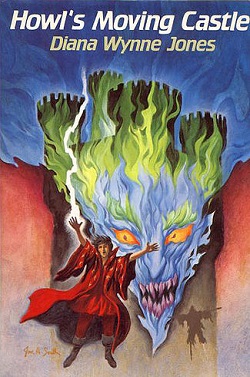 Howl’s Moving Castle (1986) is a great entry point for Diana Wynne Jones in general, but especially if you’re looking for a book with great female leads who are more than just a Strong Female Characters trope. Sophie, her sisters, and the witches start, drive, and end the story while the men – yes, even the great Wizard Howl – mostly get into trouble or make matters worse.
Howl’s Moving Castle (1986) is a great entry point for Diana Wynne Jones in general, but especially if you’re looking for a book with great female leads who are more than just a Strong Female Characters trope. Sophie, her sisters, and the witches start, drive, and end the story while the men – yes, even the great Wizard Howl – mostly get into trouble or make matters worse.
There isn’t much to tie it to Hayao Miyazaki’s absolutely wonderful movie other than the lead characters and a world made of magic, so don’t go into this expecting a comment on warfare and environmental destruction. As much as I love the movie, Jones’ world is just so much more interesting and vast. And she expands it even further with the other two entries in the series (Howl and Sophie appear in all three): Castle in the Air (1990), set in a Middle East-like nation and House of Many Ways (2008), lead by a bookish rich girl and grumpy magician’s apprentice.
Still going through Harry Potter withdrawals?
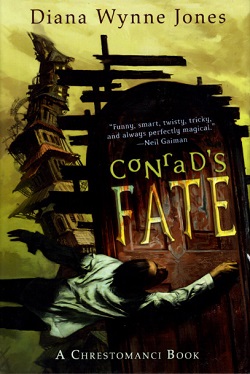 Christopher Chant is the Chrestomanci, or head honcho of monitoring the use of magic across the multiverse. The Chrestomanci series, which includes six books and one anthology of short stories, follows Christopher as he discovers his abilities, earns his title, and guides the next generation of mages. As Chrestomanci, Christopher benefits from having nine lives, but can also be summoned just by calling his name. He also appears in every book in the series.
Christopher Chant is the Chrestomanci, or head honcho of monitoring the use of magic across the multiverse. The Chrestomanci series, which includes six books and one anthology of short stories, follows Christopher as he discovers his abilities, earns his title, and guides the next generation of mages. As Chrestomanci, Christopher benefits from having nine lives, but can also be summoned just by calling his name. He also appears in every book in the series.
It’s a bit of a mix of Harry Potter and the Narnia books. Or to put it another way, children going on grand magical adventures while adults get in the way. Of course you can read the series in any order but I suggest a slightly updated version of what Jones preferred – Charmed Life (1977), The Lives of Christopher Chant (1988), Conrad’s Fate (2005), Witch Week (1982), The Magicians of Caprona (1980), The Pinhoe Egg (2006), and Mixed Magics (2000).
Random weirdness
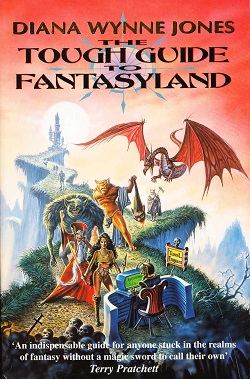 Some of my favorite books by fantasy fiction writers is when they twist into weird non-fiction. Douglas Adams’ The Meaning of Liff is basically what a dictionary written by P.G. Wodehouse would sound like. Neil Gaiman’s Ghastly Beyond Belief is some of the weirdest stuff he’s ever written. The Tough Guide To Fantasyland (1996) is part satirical encyclopedia, part parody travel guide, and all blithely irreverent. It’s based on the notion that the fantasy worlds in fiction are a real place, a theme park essentially, that can be visited on a package holiday. The tourist can take a fantasy adventure similar to those in books and what to do when encountering characters who usually pop up in them.
Some of my favorite books by fantasy fiction writers is when they twist into weird non-fiction. Douglas Adams’ The Meaning of Liff is basically what a dictionary written by P.G. Wodehouse would sound like. Neil Gaiman’s Ghastly Beyond Belief is some of the weirdest stuff he’s ever written. The Tough Guide To Fantasyland (1996) is part satirical encyclopedia, part parody travel guide, and all blithely irreverent. It’s based on the notion that the fantasy worlds in fiction are a real place, a theme park essentially, that can be visited on a package holiday. The tourist can take a fantasy adventure similar to those in books and what to do when encountering characters who usually pop up in them.
With Tough Guide, Jones skewers sword and sorcery like it’s going out of business. She leaves no stone unturned and no field unpillaged, but there’s nothing but love and affection in her words. She understands every dark corner and overused cliche in this subgenre and uses her mockery to both call out the worst tropes and underscore the the most enjoyable bits.
SFF with a splash of grimdark
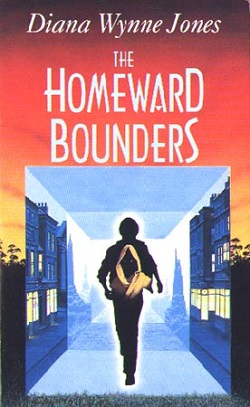 The Homeward Bounders (1981) is one of Jones’ darker books. Once again she uses the idea of a multiverse, but instead of being supervised by a genial wizard, this one is a playground for demons. When young Jamie stumbles upon the Them he’s turned into a Homeward Bounder, a person who is exempt from the hellish universe-spanning board game. No one in the game can harm him, but neither can he get involved in the game. He is also forced to wander the multiverse until he finds his home, and only then will he be released from their curse. Jamie collects other children impacted by the game and they work together to try and defeat Them. Tonally it’s the exact opposite of Howl’s Moving Castle; Jamie learns many hard, unpleasant truths about the world and his place in it. Jones once said, “I really do believe there are some people who are just irredeemable,” and that is never more prevalent than in Homeward Bounders.
The Homeward Bounders (1981) is one of Jones’ darker books. Once again she uses the idea of a multiverse, but instead of being supervised by a genial wizard, this one is a playground for demons. When young Jamie stumbles upon the Them he’s turned into a Homeward Bounder, a person who is exempt from the hellish universe-spanning board game. No one in the game can harm him, but neither can he get involved in the game. He is also forced to wander the multiverse until he finds his home, and only then will he be released from their curse. Jamie collects other children impacted by the game and they work together to try and defeat Them. Tonally it’s the exact opposite of Howl’s Moving Castle; Jamie learns many hard, unpleasant truths about the world and his place in it. Jones once said, “I really do believe there are some people who are just irredeemable,” and that is never more prevalent than in Homeward Bounders.
Award winners
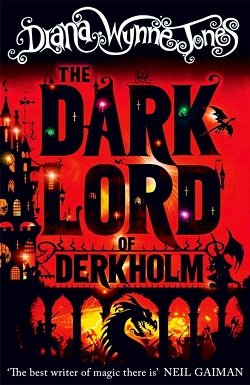 Jones won or was a finalist in the Mythopoeic Fantasy Awards multiple times, so you have your pick of titles. However, I’d recommend Dark Lord of Derkholm (1998) or The Crown of Dalemark (1993). Where Crown (the last in the Dalemark Quartet, so probably start with the first book…) takes its high fantasy setting very seriously, Derkholm is more or less a goofy parody of the genre. Think a kid version of Lancelot du Lac versus Monty Python and the Holy Grail and that’s Dalemark and Derkholm, respectively. Derkholm was indirectly inspired by Tough Guide to Fantasyland, and both books are often paired together as the Derkholm series. When the locals finally get sick of Mr. Chesney’s Pilgrim Parties, a holiday package tour, constantly destroying their villages, and set up a patsy and his human and griffin children to save their world. The Dalemark Quartet tells the history of a nation from ancient kings to present-day children. In the final story, characters from the previous books help a young girl find a magic crown and do battle against a sinister villain with a grudge.
Jones won or was a finalist in the Mythopoeic Fantasy Awards multiple times, so you have your pick of titles. However, I’d recommend Dark Lord of Derkholm (1998) or The Crown of Dalemark (1993). Where Crown (the last in the Dalemark Quartet, so probably start with the first book…) takes its high fantasy setting very seriously, Derkholm is more or less a goofy parody of the genre. Think a kid version of Lancelot du Lac versus Monty Python and the Holy Grail and that’s Dalemark and Derkholm, respectively. Derkholm was indirectly inspired by Tough Guide to Fantasyland, and both books are often paired together as the Derkholm series. When the locals finally get sick of Mr. Chesney’s Pilgrim Parties, a holiday package tour, constantly destroying their villages, and set up a patsy and his human and griffin children to save their world. The Dalemark Quartet tells the history of a nation from ancient kings to present-day children. In the final story, characters from the previous books help a young girl find a magic crown and do battle against a sinister villain with a grudge.
Archer’s Goon (1984) was nominated for a World Fantasy award, won a Boston Globe-Herald Honor Book award, and is on the American Library Association’s list of best books for children and young adults. The Sykes family gets tied up in wizard politics and jump between the past and future untangling the mystery of what the seven wizards who run their town want and to whom they are beholden. It’s a lovely, quirky story about families and secrets.
By age
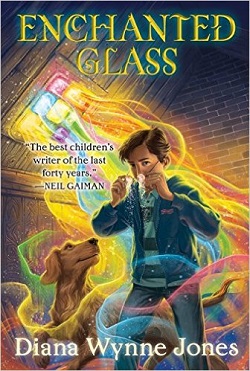 Most of Diana Wynne Jones’ books are aimed at children and young adults, but she’s also branched out into younger children and adult readers. Who Got Rid of Angus Flint? (1978) is a delightful little picture book about an unwanted friend of the family who stops by unexpectedly and just won’t leave. With only six chapters, it’s a light, fun book for young book lovers practicing their reading skills.
Most of Diana Wynne Jones’ books are aimed at children and young adults, but she’s also branched out into younger children and adult readers. Who Got Rid of Angus Flint? (1978) is a delightful little picture book about an unwanted friend of the family who stops by unexpectedly and just won’t leave. With only six chapters, it’s a light, fun book for young book lovers practicing their reading skills.
Enchanted Glass (2010) was the last book published by Jones before she passed, and it’s also coincidentally one of my favorites, second only to Howl’s Moving Castle. Perfect for older children and pre-teens, it tells of a magician and his teenage ward who unravel the secrets of Melstone House, including frustrating fairies and persnickety spells.
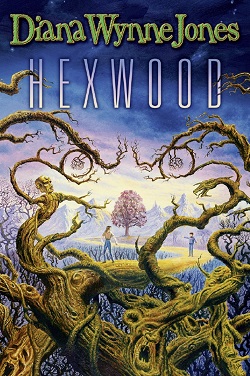 A bit darker and more mature, Hexwood (1993) is great for teenagers, especially those who appreciate blurring the lines between science fiction and fantasy. In an English estate, a strange machine called the Bannus has inexplicably been turned on and has trapped its caretakers on the property. Ann sneaks onto the property and encounter powerfully magical beings as well as a boy named Hume and his robot. The Bannus screws with the humans, magicians, and a race of galaxy-controlling dictators, and it’s up to Ann and Hume to sort the whole mess out. The story is a bit convoluted – like, seriously convoluted – but it’s worth the muddle through.
A bit darker and more mature, Hexwood (1993) is great for teenagers, especially those who appreciate blurring the lines between science fiction and fantasy. In an English estate, a strange machine called the Bannus has inexplicably been turned on and has trapped its caretakers on the property. Ann sneaks onto the property and encounter powerfully magical beings as well as a boy named Hume and his robot. The Bannus screws with the humans, magicians, and a race of galaxy-controlling dictators, and it’s up to Ann and Hume to sort the whole mess out. The story is a bit convoluted – like, seriously convoluted – but it’s worth the muddle through.
Adults can easily read any of Jones’ books and get something wonderful out of them, but A Sudden Wild Magic (1992) is specifically written for them. Again Jones delves into the messiness of a multiverse in the need of supervision, this time by a coven of witches. A gaggle of magicians from another universe start mucking about in ours and the witches send some enchantresses over to put them in their place. Things go haywire from there as everyone works for and against each other. The themes are definitely adult here, although nothing salacious. In a lot of ways it reminds me of A.A. Milne’s grownup stories compared to his Winnie the Pooh stuff. It’s the same kind of humor just directed at a more mature target.
Alex Brown is an archivist, research librarian, writer, geeknerdloserweirdo, and all-around pop culture obsessive who watches entirely too much TV. Keep up with her every move on Twitter and Instagram, or get lost in the rabbit warren of ships and fandoms on her Tumblr.









